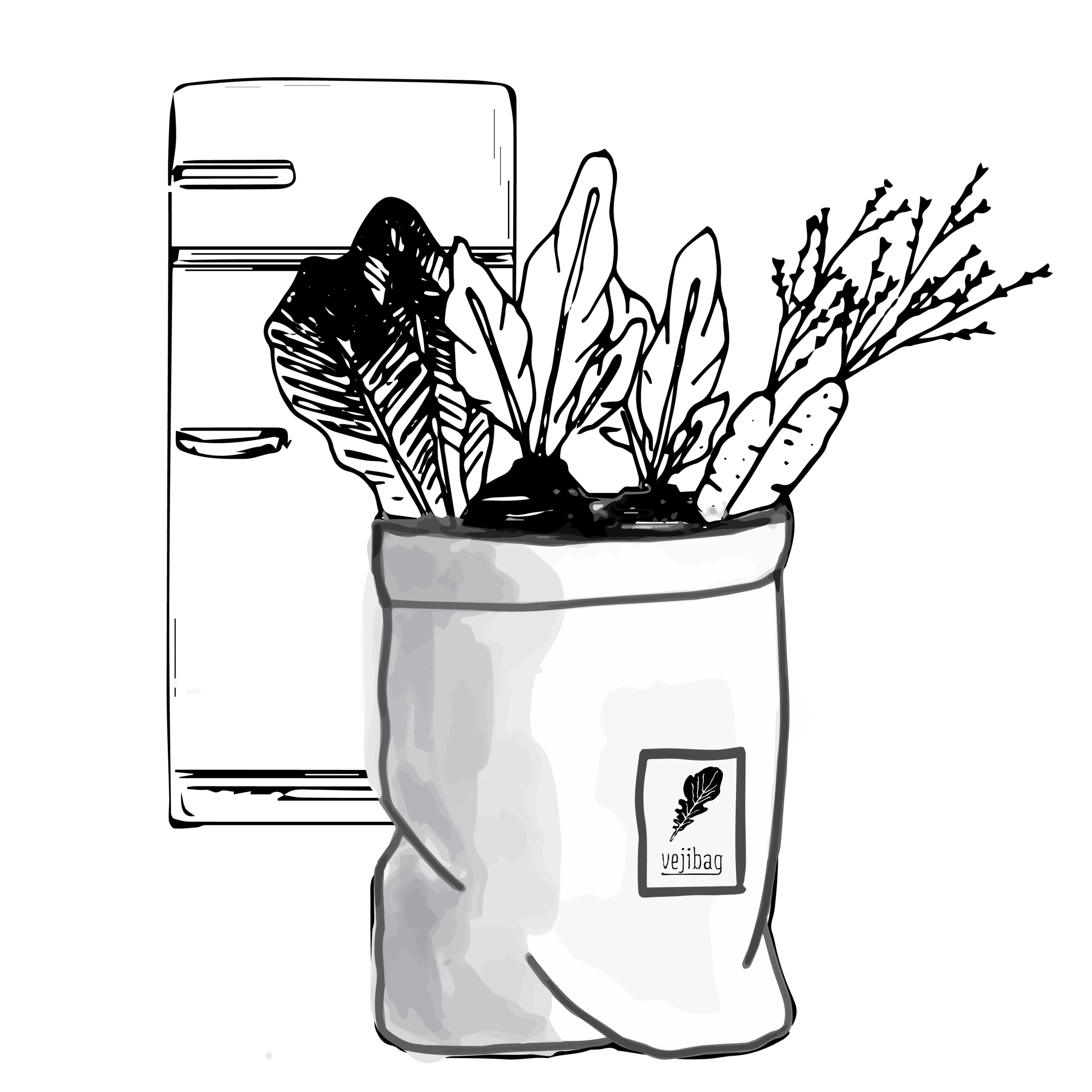USE & CARE
-

STEP 1: WET THE BAG, THEN WRING IT OUT.
Vejibags establish a moist, breathable environment for your produce. To begin, wet the bag and then wring it out so that it is just damp.
-

STEP 2: RINSE VEGETABLES.
Rinse your vegetables carefully, remove any damaged areas, and then gently shake off any excess water. If you're washing lettuces or greens, there's no need to spin. Let your Vejibag do the work!
-

STEP 3: STORE AND DAMPEN AS NEEDED.
Vejibags establish a moist, breathable environment for your produce. To begin, wet the bag and then wring it out so that it is just damp.
CARE INSTRUCTIONS
VEJIBAGS ARE MACHINE WASHABLE AND DRYABLE
Turn Vejibags inside out and launder with fragrance free detergent. Hang in the sun to dry or machine dry, expect 10% shrinkage the first time as this is a 100% cotton bag. But don't worry, your Vejibag will stretch right back out once it is wet and filled with produce!If your bag gets stained, an environmentally friendly oxygen bleach may be used to safely remove most stains.
FAQs
Frequently Asked Questions
We want you to get the most out of our bags so here are some tips to help transistion to a new way of storing Veggies:
1. I have spots and stains on my Vejibag what is causing this?
It is likely that you need to check the temperature in your fridge to ensure that it is cool enough. Most molds will not grow at temperatures below 39 degrees. For the best storage of most vegetables, temperatures just above 32 degrees are optimal. Many of our customers are surprised to learn that the area of the refrigerator where they are storing produce is warmer than they realized. If you have a thermometer, even just an outdoor thermometer, placing it in the space where you store your vegetables in the Vejibag will help diagnose any potential temperature issue. Keep in mind as well that over time, some staining is bound to occur with use as blemishes on your produce come into contact with your bag.*Here is a website we use frequently that specifies the ideal temperature and humidity conditions for storing fruits and vegetables:https://www.engineeringtoolbox.com/fruits-vegetables-storage-conditions-d_710.html
2. How can I remove spots and stains from my Vejibags?
We recommend soaking them in distilled vinegar and hot water and then laundering. For more stubborn spots and stains, you can soak the bags in a mixture of hydrogen peroxide and hot water or use your favorite oxygen bleach, before laundering the bags.
3. How do you keep Vejibags damp?
A spray bottle is a great way to refresh a Vejibag to prevent it from drying out. Alternatively, you can remove the contents of your Vejibag and use the tap again to dampen and then wring out your bag.
4. Can I keep different types of vegetables in my Vejibag?
Different types of produce can certainly be mixed in your Vejibags - many customers find that they prefer to keep certain items together depending on what is used more/less frequently. Personally, we prefer to keep our leafy greens, especially delicate loose salad greens in their own separate bag(s) so that we don't have to go weeding through for other bulkier items!
5. Can I put pre-cut vegetables in my Vejibag?
You can absolutely use your bags for cut, sliced or prepared produce. Some great uses include apple slices, baby carrots, cucumber slices, bell peppers, even leftover salad mix - as long as there is no dressing :) We have found that Vejibags lend themselves very well to "food prep" for salads in particular, allowing you to create your own custom plastic free versions of salad in a bag for the week ahead! Additionally, the ability to better store that other half of the apple or pepper slices greatly reduces food waste.
6. Do I need to wash produce before placing in in the Vejibag?
Whether or not you want to rinse the spinach first is up to you and you and we have customers who prefer to wash everything first before placing produce in Vejibags, as well as some who wash later right before use. If transferring from an already bagged product, we do recommend washing the veggies and removing any wilted leaves, shaking out excess water, and then placing the produce in the bag.
7. What sizes do Vejibags come in?
Standard: 11x12 inchesLarge: 11X17 inchesExtra Large: 14X17 inchesTwo-Pocket: 11x14 inchesFor more details about each bag, including dimensions and suggestions about the produce they can hold, you can visit the Shop section of our website.
8. Should I wash my Vejibag between uses?
We recommend laundering or hand washing Vejibags between uses with a fragarance free soap or detergent. To sanitize the bags, we recommend a hot dryer or air drying in the sun. This allows potential contaminants to get washed away before introducing fresh vegetables. Machine washing and drying will cause about 10% shrinkage, as Vejibags are made from 100% cotton - but don't worry - the bags will stretch right back out again when they get wet!
9. What should I do with my old/worn out Vejibags?
With proper care, you can expect your Vejibags to last for years. Once you feel that your Veijbag has done it's time and is worn out beyond use, you can actually compost it since it is made from 100% nontoxic biodegradable material. Many of us have found that cutting it up and turning it into rags for other purposes works well too!
10. How are Vejibags packed and shipped?
Veijbags ordered on our Website are shipped via USPS Ground Advantage. The bags will arrive packed in our plastic free, curbside recyclable packaging (even the label). Our mailers are manufactured by Ecoenclose in the United States.



